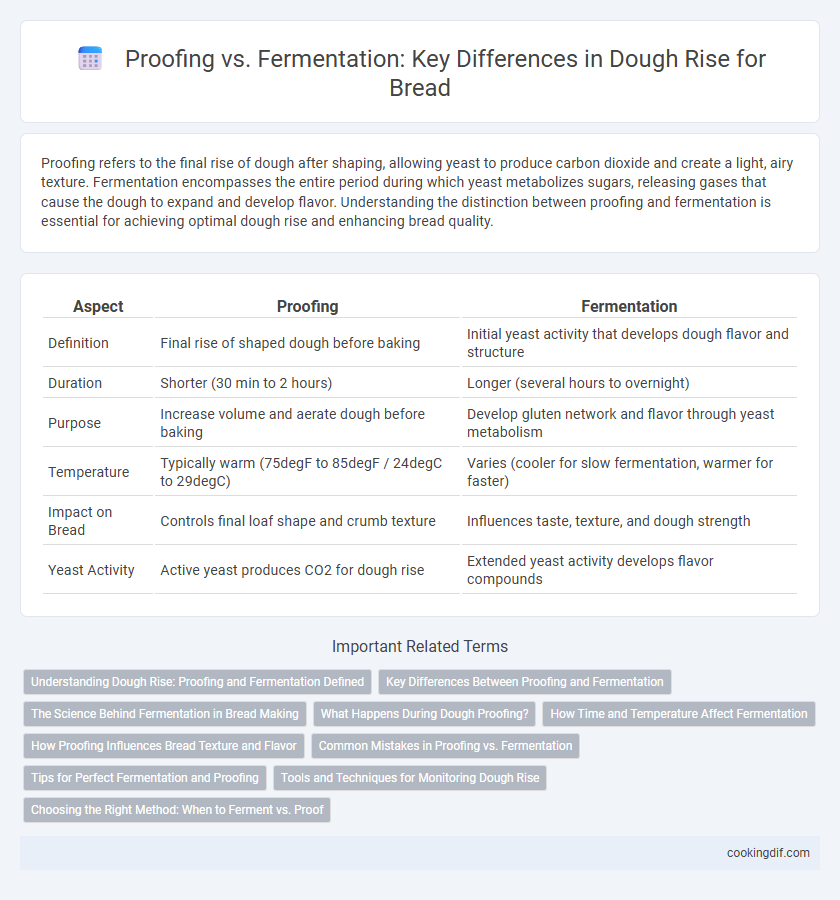Proofing refers to the final rise of dough after shaping, allowing yeast to produce carbon dioxide and create a light, airy texture. Fermentation encompasses the entire period during which yeast metabolizes sugars, releasing gases that cause the dough to expand and develop flavor. Understanding the distinction between proofing and fermentation is essential for achieving optimal dough rise and enhancing bread quality.
Table of Comparison
| Aspect | Proofing | Fermentation |
|---|---|---|
| Definition | Final rise of shaped dough before baking | Initial yeast activity that develops dough flavor and structure |
| Duration | Shorter (30 min to 2 hours) | Longer (several hours to overnight) |
| Purpose | Increase volume and aerate dough before baking | Develop gluten network and flavor through yeast metabolism |
| Temperature | Typically warm (75degF to 85degF / 24degC to 29degC) | Varies (cooler for slow fermentation, warmer for faster) |
| Impact on Bread | Controls final loaf shape and crumb texture | Influences taste, texture, and dough strength |
| Yeast Activity | Active yeast produces CO2 for dough rise | Extended yeast activity develops flavor compounds |
Understanding Dough Rise: Proofing and Fermentation Defined
Proofing and fermentation are critical stages in dough rising, with fermentation referring to the entire process where yeast consumes sugars to produce carbon dioxide and alcohol, causing dough expansion. Proofing specifically denotes the final rise after shaping, enhancing dough texture and volume before baking. Optimal proofing and fermentation temperatures range between 75degF and 85degF, ensuring balanced yeast activity and gluten development for an ideal crumb structure.
Key Differences Between Proofing and Fermentation
Proofing refers to the final rise of shaped dough before baking, allowing yeast to develop air bubbles that create a light texture. Fermentation is the broader process where yeast consumes sugars to produce carbon dioxide and alcohol, occurring from mixing until proofing. Key differences include timing, purpose, and impact on flavor, with fermentation contributing to dough maturation and proofing primarily focusing on volume expansion.
The Science Behind Fermentation in Bread Making
Fermentation in bread making is a biochemical process where yeast converts sugars into carbon dioxide and alcohol, causing the dough to rise and develop flavor. This metabolic activity not only creates air pockets, enhancing the bread's texture, but also produces organic acids that improve dough elasticity and taste. Understanding the enzymatic breakdown of starches and proteins during fermentation is crucial for optimizing dough structure and achieving superior crumb quality.
What Happens During Dough Proofing?
Dough proofing is the final rise that occurs after shaping and before baking, where yeast ferments the sugars producing carbon dioxide gas that causes the dough to expand. During proofing, enzymes break down starches into fermentable sugars, enhancing flavor and texture development. This stage is crucial for achieving a light, airy crumb and optimal dough elasticity.
How Time and Temperature Affect Fermentation
Fermentation time and temperature critically influence dough rise by regulating yeast activity and gas production. Optimal fermentation occurs between 75degF and 85degF, where yeast rapidly consumes sugars, producing carbon dioxide and alcohol, resulting in ideal dough expansion. Extended fermentation at lower temperatures slows yeast metabolism, enhancing flavor complexity through longer enzymatic reactions without overproofing the dough.
How Proofing Influences Bread Texture and Flavor
Proofing significantly impacts bread texture and flavor by allowing yeast to consume sugars, producing carbon dioxide and alcohol that create a light, airy crumb and complex taste. During proofing, gluten structure relaxes and strengthens, resulting in improved dough elasticity and a tender crust. Extended proofing times develop deeper, richer flavors through enhanced enzymatic activity and yeast fermentation.
Common Mistakes in Proofing vs. Fermentation
Common mistakes in proofing include under-proofing, which results in dense bread, and over-proofing, causing collapsed dough. During fermentation, inconsistent temperatures can disrupt yeast activity, leading to uneven rise and poor flavor development. Proper control of time and environment is crucial to balance fermentation and proofing for optimal dough texture and taste.
Tips for Perfect Fermentation and Proofing
Achieving perfect dough rise hinges on controlling temperature and humidity during proofing and fermentation, ideally maintaining 75-80degF with 75% humidity for optimal yeast activity. Use a proofing box or a warm, draft-free spot to ensure consistent conditions and cover the dough with a damp cloth to prevent drying. Monitoring dough elasticity and volume increase by 50-100% signals readiness for baking, ensuring enhanced texture and flavor development.
Tools and Techniques for Monitoring Dough Rise
Precision in dough rise is achieved through advanced proofing tools such as humidity-controlled proofing boxes and temperature-regulated proofing chambers that create optimal environments for yeast activity. Techniques like using digital thermometers and rise gauges enable bakers to monitor dough temperature and volume increase accurately, ensuring consistent fermentation results. Time-lapse photography and smart fermentation apps offer innovative methods for tracking dough rise dynamics, enhancing control over texture and flavor development.
Choosing the Right Method: When to Ferment vs. Proof
Fermentation is ideal for developing complex flavors and improving dough texture during the initial dough rise, while proofing is used primarily for the final rise after shaping to achieve optimal volume. Home bakers should choose fermentation for long, slow rises that enhance yeast activity and gluten structure, whereas proofing is best for short, controlled rises that prepare dough for baking. Commercial bakeries often combine both methods to maximize flavor depth and achieve consistent dough expansion.
Proofing vs Fermentation for dough rise Infographic

 cookingdif.com
cookingdif.com